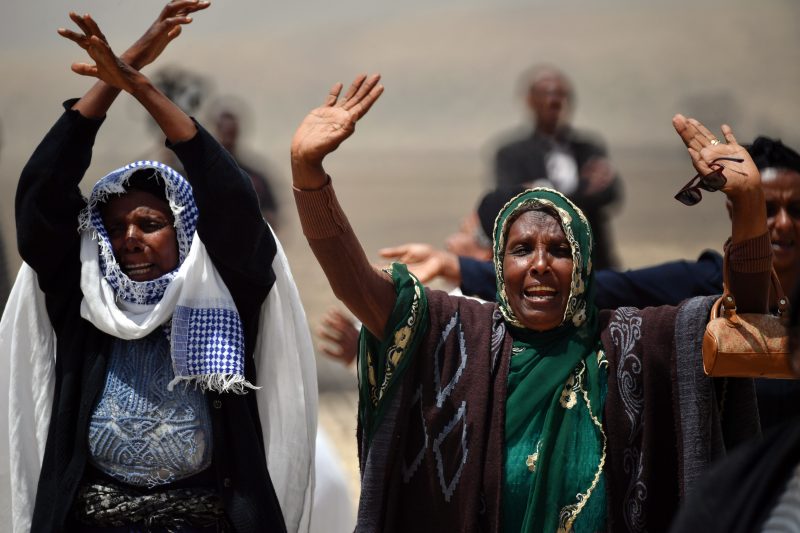France probes 737 MAX black boxes as Boeing halts deliveries
Distraught relatives at the site of an Ethiopian Airlines Boeing 737 MAX 8 plane crash that killed 157 people (TONY KARUMBA)
Paris (AFP) – A French investigation into the Ethiopian Airlines 737 MAX crash that killed 157 passengers and crew opened Friday as US aerospace giant Boeing stopped delivering the top-selling aircraft.
The MAX has been grounded worldwide following the disaster — the second involving the model in five months — and the fallout has left the company, regulators and airlines scrambling to respond.
“We are pausing the delivery of the 737 MAX until we come up with a solution,” a Boeing spokesman said Thursday, adding: “We are going to continue the production but we are assessing our capacities.”
An Ethiopian delegation delivered the black boxes to France’s BEA air safety agency “and the investigation process has started in Paris”, Ethiopian Airlines said Friday on Twitter.
The BEA confirmed it had received the black box recorders from the plane, which was just four months old and crashed minutes after takeoff from Addis Ababa on Sunday.
BEA investigators will now try to retrieve information from the cockpit voice and flight data recorders, which were damaged in the disaster.
Thousands of miles (kilometers) away, distraught families were demanding answers as they visited the deep black crater where the plane smashed into a field outside the capital, disintegrating on impact.
Ethiopian Airlines, Africa’s largest carrier, sent the black boxes to France because it does not have the equipment to analyze the data.
The information that they contain helps explain 90 percent of all crashes, according to aviation experts.
On Wednesday, US authorities said new evidence showed similarities between the Ethiopia crash and that of a Lion Air flight in Indonesia in October that killed 189 people.
The US Federal Aviation Administration (FAA) said findings from the crash site and “newly refined satellite data” warranted “further investigation of the possibility of a shared cause for the two incidents.”
– Boeing shares hit –
An FAA emergency order grounded 737 MAX 8 and MAX 9 aircraft until further notice, effectively taking the aircraft out of the skies globally.
The move came after a growing number of airlines and countries decided not to fly the planes or ban them from their airspace until it is determined there are no safety issues.
US President Donald Trump told reporters the “safety of the American people and all peoples is our paramount concern”.
FAA acting chief Daniel Elwell said the agency had been “working tirelessly” to find the cause of the accident but faced delays because of the damage to the flight data recorders.
The new information shows “the track of that airplane was close enough to the track of the Lion Air flight” to warrant the grounding of the airplanes so more information can be gathered to determine if there is a link, Elwell said Wednesday on CNBC.
Boeing’s shares have fallen 12 percent in the days after the crash in Ethiopia, wiping out nearly $30 billion in value.
The 737 MAX series is Boeing’s fastest-selling model and it is still relatively new with fewer than 500 in service.
There are 74 registered in the United States and 387 in use worldwide with 59 carriers, according to the FAA.
– Pilots’ concerns –
The accounts of the recent crashes were echoed in concerns registered by US pilots on how the 737 MAX 8 behaves.
At least four American pilots complained following the Lion Air crash that the aircraft would suddenly pitch downward shortly after takeoff, according to documents reviewed by AFP on the Aviation Safety Reporting System, a voluntary incident database maintained by NASA.
In two anonymous reports on flights just after the Lion Air disaster, pilots disconnected the autopilot and corrected the plane’s trajectory in response.
It was unclear if US transport authorities review the database or investigated the incidents.
However, the FAA said this week it had ordered Boeing to update its flight software and training.
Questions about the Lion Air crash have honed in on a stall prevention system, the MCAS, designed to automatically point the plane’s nose downwards if it is in danger of stalling.
According to the flight data recorder, the pilots of Lion Air Flight 610 struggled to control the aircraft as the MCAS repeatedly pushed the nose down after takeoff.
The Ethiopian Airlines pilots reported similar difficulties before their aircraft plunged to the ground.
According to The New York Times, air traffic controllers observed the Ethiopian Airlines plane “oscillating up and down by hundreds of feet” prior to the crash.
Speaking in a “panicky voice,” the doomed aircraft’s captain requested permission to return to the airport almost immediately after takeoff as the plane “accelerated to abnormal speed,” the newspaper reported Thursday, citing a person who had reviewed the air traffic communications.
“Break break, request back to home,” the Times quoted the pilot as saying just prior to the crash. “Request vector (direction) for landing.”
Boeing was criticized after the Lion Air crash for allegedly failing to adequately inform 737 pilots about the functioning of the stall prevention system.
Ethiopian Airlines CEO Tewolde GebreMariam said the doomed flight’s captain was an experienced aviator with more than 8,000 flight hours.
burs/jh/bmm
Disclaimer: This story is published from a syndicated feed. Siliconeer does not assume any liability for the above story. Validity of the above story is for 7 Days from original date of publishing. Content copyright AFP.


